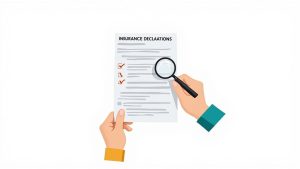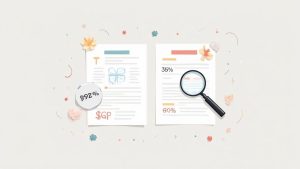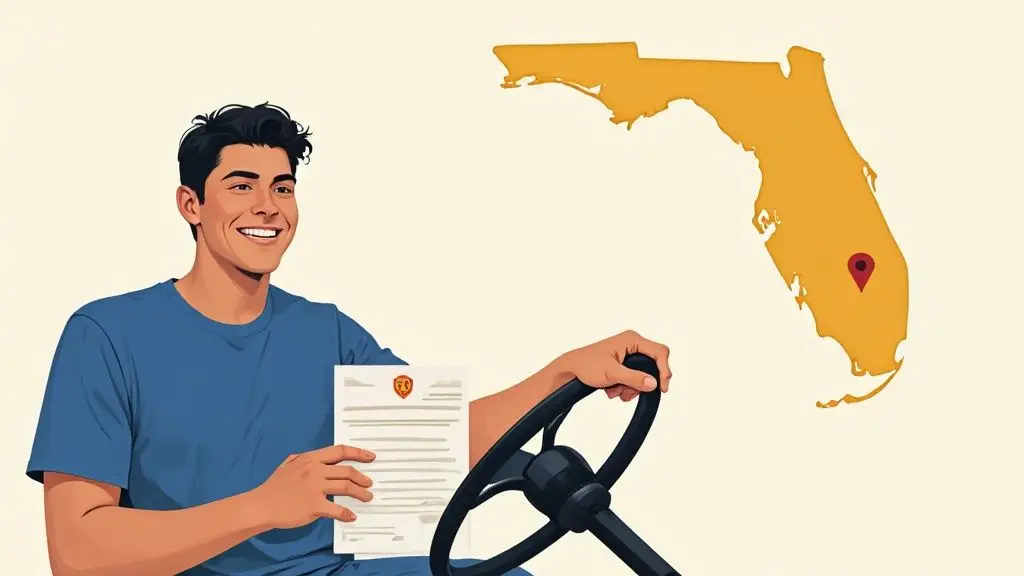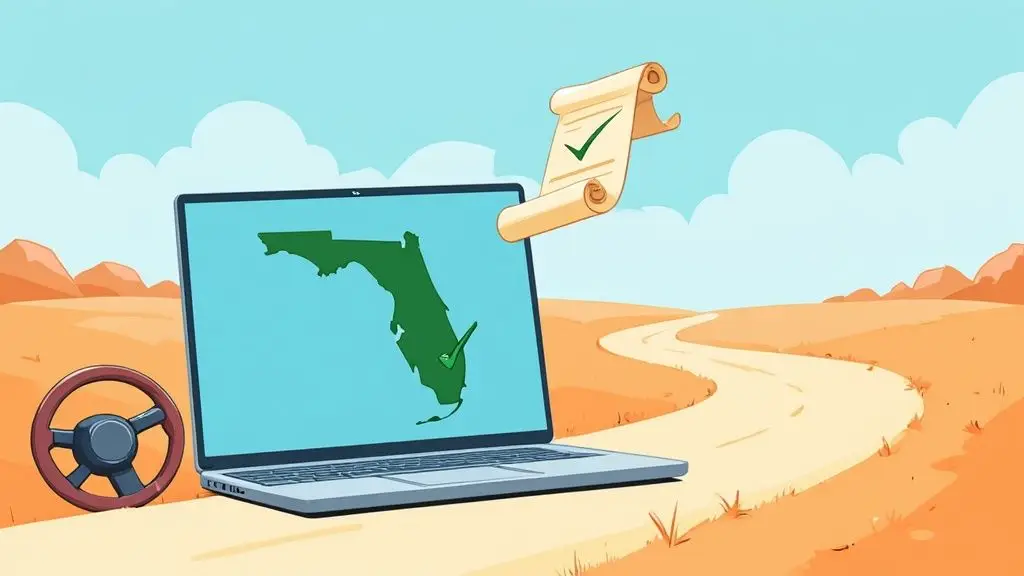Want to save money on car insurance? The first step isn’t shopping around—it’s understanding what you already have. You need to get proactive by reviewing your coverage, checking your deductibles, and making sure your policy still fits your life. A little time spent here can unlock significant savings without leaving you underprotected.
Give Your Policy a Quick Health Check

Before you can slash your premium, you need a clear picture of what you’re paying for right now. Think of it as a financial check-up for your car insurance. Your policy is more than just a bill; it’s a contract that spells out every detail of your protection on the road.
Your best friend in this process is the declarations page. This one-page summary is basically the cheat sheet for your entire policy. It breaks down all the important stuff: your specific coverages, limits, deductibles, and exactly what you’re paying for each. This is where you’ll find the dollar amounts for liability, collision, and comprehensive coverage.
What to Look For on Your Declarations Page
As you scan this document, ask yourself a few questions. The answers can immediately point to areas where you might be over-insured (or even under-insured), revealing some quick wins for your wallet.
- Do my liability limits make sense? These are the big numbers, often written as 100/300/50, that protect your assets if you cause an accident. Are they high enough to cover you, or are you paying for more protection than your financial situation warrants?
- Is my deductible too low? A $500 deductible is pretty standard, but bumping it up to $1,000 can often lower your premium noticeably. The key question is: could you comfortably pay that higher amount out-of-pocket if you had to file a claim tomorrow?
- Am I paying for coverage I don’t need anymore? If you’re driving an older car that’s paid off, carrying full collision and comprehensive coverage might not be worth it. In some cases, the annual cost for that coverage can be more than the car is even worth.
- Are all my discounts listed? Don’t assume they’re all there. Double-check that you’re getting credit for things like being a good student, having anti-theft devices, or bundling your home and auto policies.
Match Your Coverage to Your Current Life
Life changes, so your insurance should change with it. The perfect policy from two years ago could be a money-waster today.
A policy review isn’t just about cutting costs—it’s about ensuring your coverage is still relevant. Mismatched coverage is one of the most common ways drivers unknowingly overspend on their premiums.
Think about what’s different now. Did you recently start working from home and slash your commute? Did you just pay off your car loan? These kinds of changes are prime opportunities to lower your premium. And of course, your driving history is a huge factor. It’s always smart to know where you stand, so check out our guide on how to check your driving record to make sure it’s accurate.
Taking a few minutes for this policy health check is the groundwork for every other money-saving strategy to come.
Top Strategies to Lower Your Car Insurance
To give you a quick overview, here are some of the most effective ways drivers can reduce what they pay each year.
| Strategy | Potential Savings | Action Required |
|---|---|---|
| Increase Your Deductible | 15% – 30% on collision/comp | Review your budget and raise your deductible to a manageable level (e.g., from $500 to $1,000). |
| Shop and Compare Quotes | Up to $500+ annually | Get quotes from at least three different insurers every year, comparing identical coverage levels. |
| Ask About Discounts | 5% – 25% or more | Call your agent and ask for a full discount review (bundling, good student, safe driver, etc.). |
| Complete a Driving Course | 5% – 10% | Enroll in an insurer-approved defensive driving course to earn a mandatory discount. |
| Maintain Good Credit | Varies by insurer and state | Pay bills on time and manage debt to improve your credit-based insurance score over time. |
These strategies, starting with a simple policy review, are your roadmap to finding real, tangible savings.
Master the Art of Comparison Shopping

When it comes to car insurance, blind loyalty can cost you a small fortune. Insurers are constantly fine-tuning how they price their policies, so the company that offered you the best deal last year could easily be one of the most expensive this time around. That’s why the single most powerful tool in your financial arsenal is learning how to effectively shop around.
It’s actually pretty simple. Every insurance company calculates risk using its own unique, and often secret, formula. One might heavily penalize a single speeding ticket, while another is more focused on the theft rate in your ZIP code. This is exactly why you can get wildly different quotes for the exact same coverage—they’re all playing a different game.
Get Your Ducks in a Row for an Accurate Quote
Before diving into online quote forms, take a few minutes to get your information together. A little prep work upfront prevents you from guessing on important details and ensures the quotes you receive are actually reliable.
Here’s what you’ll want to have on hand:
- Your Current Policy: Grab the declarations page. It’s the perfect blueprint for the coverage levels you need to match.
- Driver Details: This includes the driver’s license numbers and birthdates for everyone you want on the policy.
- Vehicle Information: The make, model, year, and Vehicle Identification Number (VIN) for each car.
- Driving History: Be ready to honestly report any tickets or accidents from the last three to five years.
I tell everyone to make comparison shopping an annual ritual. The sweet spot to start looking is about 30 days before your current policy renews. This gives you more than enough time to weigh your options without being rushed into a bad decision at the last minute.
Look Beyond the Absolute Lowest Price
While the goal is to save cash, the cheapest premium isn’t always the best deal. A rock-bottom price can sometimes mask terrible customer service or a claims process designed to frustrate you. After an accident, the last thing you need is an insurer that ghosts you.
Don’t just compare premiums; compare the overall value. A slightly higher price might be well worth it for an insurer known for fast, fair claims handling and having a real human answer the phone. This is a crucial part of saving money on insurance without sacrificing your sanity.
Take a few extra minutes to look up customer satisfaction ratings from reliable sources like J.D. Power or your state’s department of insurance. See how these companies perform when their customers actually need them most.
Make Sure You’re Comparing Apples to Apples
This is the number one mistake I see people make. They get excited about a quote that seems incredibly cheap, only to realize it has a $2,500 deductible while their current policy has a $500 one. That’s not a fair fight.
To get a true side-by-side comparison, every quote must have identical:
- Liability Limits: If you have 100/300/50 (bodily injury and property damage), make sure the new quote does too.
- Deductibles: The comprehensive and collision deductibles need to match across the board.
- Extra Coverages: If you have add-ons like rental car reimbursement or roadside assistance, make sure they’re included in the new quotes.
When you treat comparison shopping as a strategic move rather than a chore, you put yourself in control. It’s the discipline that ensures you’re not just finding a cheaper policy, but the right policy at the absolute best price.
Uncover the Discounts Your Insurer Isn’t Advertising

Sure, shopping around is smart, but you’d be surprised by the savings hiding in plain sight with your current insurer. Insurance companies have a whole menu of discounts available, but they rarely apply them automatically or shout them from the rooftops. Most of the time, you have to ask.
It’s easy to assume you’re getting all the discounts you qualify for, especially the big ones. But the real magic happens when you start stacking the smaller, less-obvious price breaks. Those little percentages add up quickly, and it’s on you to find them.
Look Beyond the Obvious Savings
Everyone’s heard of bundling, but it’s still one of the most effective ways to save. Combining your home and auto policies can slash your bill by up to 18%. If you insure multiple cars, that discount can climb as high as 25%.
But don’t stop there. A whole world of savings opportunities opens up once you get past the basics. Your agent isn’t going to volunteer every single one, so you need to take the lead and ask specific questions about your car, your job, and how you drive.
A Checklist for Finding Hidden Discounts
It’s time to play detective with your own policy. Many insurers offer price breaks for things you’d never think to mention. The next time you talk to your agent, run through this list and ask about each one directly.
- Your Profession or Affiliations: Are you a teacher, nurse, first responder, or a member of the military? Many companies offer discounts for certain professions. Same goes for alumni associations, professional groups, and even warehouse clubs like Costco.
- Your Car’s Features: Does your vehicle have factory anti-theft systems, anti-lock brakes, or daytime running lights? Each of these safety and security features can shave a little bit more off your premium. They reduce risk, and insurers love that.
- How You Pay: This one is easy. Just by switching to paperless billing or paying your entire six-month premium upfront (paid-in-full discount), you can often score an instant price cut.
- Low-Mileage: If you work from home, have a short commute, or just don’t drive much, you could qualify for a low-mileage discount. Less time on the road means less risk, which translates to savings for you.
Remember, your insurer’s job is to price risk, not to be your personal savings consultant. A quick, 15-minute phone call armed with these questions could easily save you hundreds of dollars a year. It’s your money, after all.
One of the most surefire ways to lower your premium is to prove you’re a safe, low-risk driver. Completing a state-approved defensive driving course is a fantastic way to do just that. It doesn’t just make you a better driver; it almost always comes with a discount that lasts for years. You can learn more about how a driver safety course can lead to an insurance discount and see if it makes sense for your situation. The small cost of the course often pays for itself many times over.
Adjust Your Coverage Without Taking Big Risks
Paying for insurance you don’t actually need is a classic case of throwing money away. The goal isn’t to slash your protection to the bone, but to get strategic. It’s about tailoring your policy to fit your life right now—your financial situation, your car’s age, and its real-world value.
One of the most direct ways to lower your premium is to take a hard look at your deductible. Remember, the deductible is what you pay out-of-pocket on a claim before the insurance company pays a dime. It’s a simple seesaw: when your deductible goes up, your premium almost always goes down.
Find Your Deductible Sweet Spot
How much of a difference does it make? Bumping your deductible from $500 to $1,000 can often knock 15% to 30% off your collision and comprehensive costs.
The trick is to be honest with yourself. Could you comfortably write a check for $1,000 tomorrow if you had to? If that amount would send you scrambling, then the monthly savings probably aren’t worth the risk. This is where a healthy emergency fund comes in—it gives you the freedom to choose a higher deductible and reap the savings with peace of mind.
The sweet spot is a deductible high enough to save you money every month but low enough that it wouldn’t stop you from actually using your insurance when you need it.
As you fine-tune your policy, it’s also smart to evaluate other protections. For instance, understanding how much uninsured motorist coverage you need is critical for shielding yourself from drivers who aren’t properly insured.
When to Drop Collision and Comprehensive Coverage
The next big move to consider involves your collision and comprehensive coverages. These are the parts of your policy that pay to fix your car. While they’re non-negotiable for a new or financed vehicle, they can become a waste of money as your car gets older.
Here’s a great rule of thumb I’ve seen people use for years: the “10% rule.”
If your annual premium for collision and comprehensive coverage is more than 10% of what your car is actually worth, it might be time to drop them.
Let’s run the numbers. Say your trusty old car has a Kelley Blue Book value of $4,000. You check your policy and realize you’re paying $500 a year for full coverage. That’s 12.5% of the car’s total value! You’re essentially paying a hefty fee to protect an asset that’s rapidly losing value.
In a situation like that, you could pocket that $500 and put it toward future car repairs or, better yet, a down payment on your next vehicle. It’s a calculated decision, weighing the premium cost against your car’s value and your ability to cover a replacement. This is exactly the kind of smart trade-off savvy drivers make to keep their insurance costs down.
Turn Your Safe Driving into Real Savings

Your good habits behind the wheel are more than just smart practice—they’re a real financial asset. Insurers are always looking for ways to identify low-risk drivers, and if you can prove you’re one of them, you can unlock some serious discounts. This is about more than just having a clean record; it’s about actively demonstrating that you’re a safe bet.
One of the most popular ways to do this is with telematics, often called usage-based insurance (UBI). It might sound a bit futuristic, but the concept is straightforward. You let your insurer monitor your driving—usually via a simple smartphone app or a small plug-in device for your car—and in return, you get a discount based on your actual, real-world driving habits.
Let Your Good Habits Pay You Back
These programs aren’t playing “Big Brother.” They’re simply tracking a few key behaviors that are proven indicators of a safe driver.
Most telematics programs focus on things like:
- Hard Braking & Acceleration: Are your starts and stops smooth and controlled?
- Speed: Do you consistently drive at or below the speed limit?
- Time of Day: Driving late at night is statistically riskier, so sticking to daytime hours helps your score.
- Mileage: The less you’re on the road, the lower your overall risk.
If you’re already a careful driver who avoids speeding and late-night joyrides, a UBI program is a no-brainer. It finally gives you a way to influence your premium based on your skills, not just statistics.
By sharing your driving data, you’re essentially telling your insurer, “Don’t just judge me by my age or ZIP code—judge me by how I actually drive.” This can lead to discounts of up to 30% for the safest drivers.
Invest a Few Hours for Years of Savings
Here’s another fantastic strategy: complete a defensive driving course. These courses aren’t just for getting a ticket dismissed anymore. They’re a proactive way to lower your insurance premium for years.
Many states, including Florida, actually require insurers to give a discount to drivers who voluntarily complete an approved safety course. The small investment in the course can pay for itself over and over again through lower premiums. It’s a clear signal to your insurance company that you’re serious about safety.
Many drivers wonder what it takes to be officially recognized as a safe driver. You can dig deeper into what being a “safe driver” on a Florida license means and see how it all ties together for long-term savings.
Whether you use technology to prove your good habits or brush up on your skills with a course, you have direct control over how much you pay.
Play the Long Game for Cheaper Insurance
Everyone loves a quick discount, but the real secret to slashing your car insurance bill isn’t about a one-time coupon. It’s about playing the long game. The biggest savings come from building a solid history that makes insurance companies see you as a safe, reliable driver.
Two things really move the needle here: your driving record and your credit-based insurance score.
Keep Your Driving Record Squeaky Clean
Your driving record is pure gold to an insurer. Every at-fault accident or moving violation is a red flag that can spike your premiums for three to five years. Think about that—one mistake could cost you thousands over the long haul because it tells the insurer you’re more likely to file a claim in the future.
Keeping that record clean is one of the most effective strategies to reduce vehicle insurance costs. It’s not just about avoiding tickets; it’s about proving you’re a consistently low-risk driver.
Don’t Underestimate Your Credit-Based Insurance Score
Here’s a factor many drivers overlook: your credit-based insurance score. It’s not your regular credit score, but it’s built from similar information.
In most states, insurers use this score to predict how likely you are to file a claim. A higher score often translates directly into a lower premium.
Improving this score doesn’t happen overnight. It’s a marathon, not a sprint. Simple habits like paying your bills on time, every time, and keeping your credit card balances low will gradually build up your score. Over time, this financial responsibility pays off with cheaper insurance.
If you have an old ticket or a few points still haunting your record, don’t just wait for them to disappear. Be proactive. You can start by learning how to remove points from your driving record and take the first step toward a cleaner, cheaper future.
Your Top Car Insurance Questions, Answered
Even with the best plan, you’re bound to have a few questions about cutting your car insurance costs. That’s completely normal. I’ve pulled together some of the most common questions I hear from drivers and laid out clear, straightforward answers to help you feel confident about the choices you’re making.
How Often Should I Really Be Shopping for Insurance?
Think of it like an annual check-up for your wallet. You should be shopping for new car insurance quotes at least once a year, ideally about 30 days before your current policy renews. That’s the sweet spot for finding out if your loyalty is actually costing you money.
It’s also a must-do whenever your life changes significantly. Things like moving to a new ZIP code, buying a new car, or adding a teenager to your policy can completely scramble your rates. The company that was cheapest last year might be the most expensive after a move.
A lot of people think shopping for insurance is a huge chore. The truth is, spending 30 minutes once a year can easily put hundreds of dollars back in your pocket. It’s one of the highest-paying half-hours you’ll ever work.
Will a Driving Tracker Actually Save Me Money?
For most safe drivers, yes. But it’s not a guarantee for everyone. These telematics programs track your real-world driving habits, and if you’re the type who brakes smoothly, avoids late-night driving, and generally sticks to the speed limit, you’ll probably see a nice discount.
The catch? If the app flags what it considers risky behavior, you might not see any savings at all. The most important thing is to ask the insurer one critical question before you sign up: can my rates go up based on this data? Some companies only use it to give discounts, while others might penalize you. You need to know which policy you’re getting into.
When Should I Drop Full Coverage on an Older Car?
This is a really common question, and for good reason. Once your car is paid off and getting on in years, holding onto collision and comprehensive coverage can feel like throwing money away.
A great rule of thumb is the 10% rule. If the annual cost of your full coverage is more than 10% of what your car is actually worth, it’s probably time to drop it.
For instance, paying $500 a year for collision and comprehensive on a car with a cash value of just $3,000 doesn’t make much financial sense. You could end up paying more in premiums than you’d ever get back from a claim.
Looking for a surefire way to lower your premium? Completing a state-approved defensive driving course is one of the smartest moves you can make. BDISchool offers a convenient, fully online Basic Driver Improvement Course that’s accepted by all Florida courts and can qualify you for a valuable insurance discount. Get started today at the official BDISchool website and drive your way to bigger savings.





